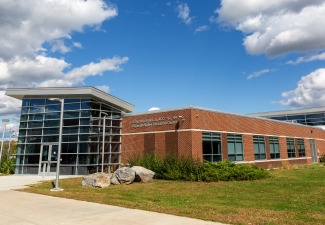Students Contribute Research to Faculty Microgrid Study | SUNY Plattsburgh
Four SUNY Plattsburgh students are helping faculty members complete a study that could lead to the development of an electric microgrid in Plattsburgh.
A microgrid serves as a backup power system that could be activated during power outages so critical facilities in the Plattsburgh areas would have access to electricity.
“We would have a facility on campus that would generate our own electricity,” said Dr. Curt Gervich, associate professor of environmental science, who started work on a project proposal after he was notified of a grant opportunity by SUNY Plattsburgh alumnus Sal Graven, who works for the New York State Energy Research and Development Authority.
Gervich did the proposal work with Dr. Lauren Eastwood, SUNY Plattsburgh associate professor of sociology, and they submitted it to the authority.
Feasibility Study
In May 2015, the authority awarded SUNY Plattsburgh a $100,000 NY Prize Microgrid Competition grant to conduct the study they are working on currently. The study will determine whether it is economically and logistically feasible to create a microgrid in Plattsburgh.
The grant is part of a three-stage statewide competition where select applicants will eventually be given funds to build a microgrid.
Assisting Gervich and Eastwood with their research are undergraduate students Aaron Baltich-Schecter ‘17, Patrick Montuori ‘16, Antwan Clark ‘17 and graduate environmental science student Kimberly Bailey ’16.
Baltich-Schecter is an aspiring economist, Montuori wants to work as a hydrogeology consultant and Clark is interested in public policy and community outreach.
“This is a great mix for the study, as all three components are part of the project,” Eastwood said.
Bailey’s work on the project is part of an internship she is completing at Willdan, a consulting and engineering firm SUNY Plattsburgh has partnered with for the study.
“She has spent countless hours tracking down information that is needed for the study,” Eastwood said.
A good part of the research has entailed gathering data from area stakeholders, including nearby Champlain Valley Physicians Hospital, the Samuel F. Vilas Home, Meadowbrook Healthcare, Plattsburgh City School District, Plattsburgh Housing Authority and the Plattsburgh Municipal Lighting District.
All of the businesses are located within the City of Plattsburgh, making the area a competitive candidate for a microgrid.
‘Project with Potential’
For their part in the study, the students created a series of presentations about microgrids and presented them in November 2015 at a community forum they organized. The forum was designed to foster discussion about the potential for a microgrid.
“We’ve got them thinking about energy in a collaborative way, which they hadn’t been doing before, and thinking about it on a community level,” Gervich said of the stakeholders.
The research group meets weekly to share their progress and brainstorm strategic ways to progress forward with their work.
The performance of the students, Gervich said, has been great.
“They’ve truly risen to the challenge,” Eastwood said. “All three undergraduate students have demonstrated significant self-starter qualities in that they have taken initiative throughout the project.”
A microgrid would help area facilities share resources, save time and save money.
And while one may never be built in Plattsburgh, the research can help the community in the future.
“We’ve collected a lot of data and had a lot of discussion and made a lot of plans,” Gervich said. “Even if we don’t build the microgrid, this work will come in handy thinking about our energy future later on.”
The student researchers say the project has helped them gain invaluable skills they will use in future jobs, including professionalism and interpersonal skills.
Beyond that, the work they have done on the project has inspired them.
The microgrid “serves as a model of what we want to see for the future—using clean and local energy,” Baltich-Schecter said.
“The project has the potential to make the community more environmentally sustainable and a safer, more attractive place to live and work,” Montuori said.
Eastwood said the students are hopeful the microgrid and projects like it will come to fruition.
“They express high hopes for such things as democratic decision making over energy choices and better understanding of the sources our energy,” she said.
The students say the teamwork needed for the study is strengthening the college’s relationship with the Plattsburgh community.
“That is another important part of the microgrid (study),” Bailey said. “It’s building a community relationship with SUNY Plattsburgh.”
News

SUNY Adirondack Students Benefit from New Dual Agreement with SUNY Plattsburgh Queensbury
